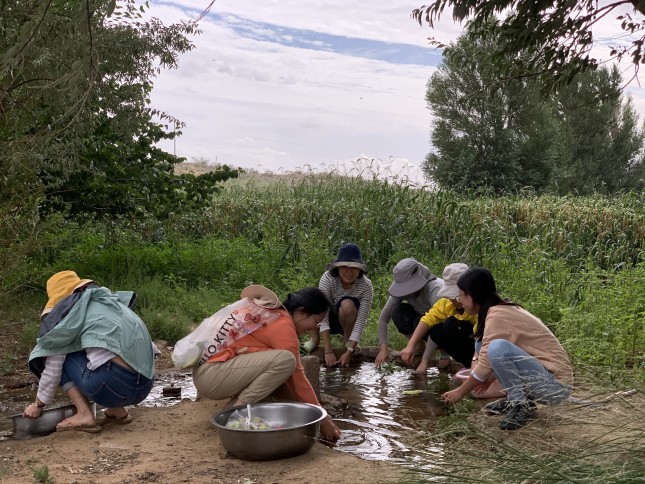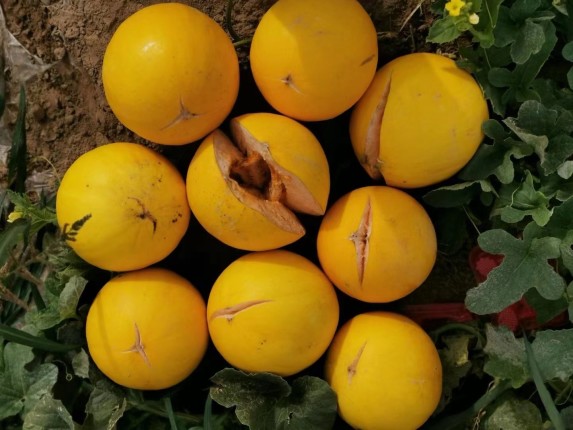-
A Warmer, Wetter Climate Challenges a Chinese Eco-farm
April 14, 2023 By Jiang MengnanIn recent years, a new narrative has appeared on Chinese social media: that a warmer and wetter climate in Northwest China will herald a return to the “golden age” of the Tang dynasty (618–907 AD).
Climate change will bring benefits, so the story goes, as historically China has flourished during warmer and wetter periods – conditions becoming common once more in the Northwest, a region extending from the province of Shaanxi to Xinjiang in the far west.
China’s Northwest is comfortably landlocked, lying far from the country’s coast, and is home to vast swathes of desert. The region’s average annual rainfall is a mere 300mm. But rising temperatures of recent decades have been accompanied by more rainfall, and more downpours and flooding. Temperatures in the region rose by 1C over the latter half of the 20th century, alongside a notable increase in rainfall between 1961 and 2018, with a significant change seen during the 1990s.
Does this mean the Northwest could be set to “benefit” from climate change? One point of view circulating online says a warmer and wetter climate will be a major boost for the region, increasing river flows and grain yields. But scientists warn that while these trends do exist, they are not pronounced enough to turn the Northwest into a wet region. At most, it will simply become somewhat less arid. And the changes may mean yields of the drought-resistant crops currently planted here actually fall, as well as an uptick in crop disease and pests.
Word from the agricultural frontline confirms this. Zhiliangtian (For Better Land, by its English name) is an eco-farm in the Alashan League, a prefecture in Inner Mongolia. Founder of the farm, Ma Yanwei, said that a warmer and wetter climate has in fact had many unexpected consequences.
Warmer, Wetter Challenges
Eco-agriculture means not using pesticides or fertilizers – something that is easier to do in an arid climate like that of Alashan, where pests and diseases have traditionally been less common. The considerable temperature differences between day and night are widely held to make crops more nutritious and tastier. Ma explained that the arid climate has informed their decisions on what crops to plant and how to plant them: drought-resistant millet and honeydew melons were chosen, with the sweet melon becoming one of the most popular agricultural products with buyers. The farm also uses drip irrigation to reduce water requirements.
More rain can change the picture considerably. Ma explained: “Last summer we saw a lot of rain and that had a big impact on our honeydew melons. First, the rain meant we couldn’t harvest the crop. Second, at this point some of the melons were ripe and very sweet. The rain increased the temperature and the difference in humidity between the outside and the inside of the fruit, which causes cracking. That resulted in big losses.”
He calculates that around a quarter of the 80 mu (5.3 hectare) of honeydew melon the farm planted in 2022 could not be harvested. That had a huge impact on yields and earnings.
And this wasn’t a one-off. Ma recalled a similar occurrence in 2018, when a dry spring followed by a cloudy and wet summer resulted in less flavor some melons: “Customers started saying the new crop weren’t as sweet and we realized that the lack of sun was a problem.”
In the end, the farm took the harvest from the last 10 mu (0.66 hectares) of land off the market, compensating affected customers by giving them fruit from the first harvest the following spring. But the financial losses were considerable.
Local farmers are also seeing more pests and diseases. One example, Ma said, is powdery mildew, a fungal disease that affects the melons during sustained rain. The disease spreads easily, with a gust of wind enough to infect a whole field and cause a reduced harvest.
Dry Springs, Wetter Summers
A good rain, according to an ancient Chinese poem, knows its season. But in Alashan, this hasn’t been the case of late. Much of the online discussion over warmer and wetter climate in the Northwest has pointed out that these conditions do not necessarily come together. In Alashan, the higher temperatures are leading to even drier springs – a challenge for crop and livestock farmers alike.
And while precipitation has increased, the extra rain is all concentrated in the summer. “2022 and 2018 were typical, in that rainfall wasn’t evenly distributed,” said Ma. “We saw very dry springs with next to no precipitation, then days of rain in summer with no sign of the sun.”
The meteorological data backs him up. Chen Yaning is a researcher at the Chinese Academy of Sciences’ Xinjiang Ecology and Geography Institute, and director of the State Key Laboratory of Desert and Oasis Ecology. In an interview with The Intellectual, he said that the number of days with rain in the Northwest hadn’t increased significantly, that the increase in rainfall was “to a great extent the result of more intense rainfall events or downpours” and that this more extreme precipitation could “increase the risk of drought or localized flooding.”
While Zhiliangtian has chosen its crops to cope with arid climates, other local farmers who plant water-hungry crops like maize, and who do not use drip irrigation, may find the changes yet harder to cope with. “The dry springs are even worse for those farmers and they will see smaller harvests,” said Ma.
Livestock farmers are also facing problems. Traditionally, such farmers in Alashan raise sheep from the spring and sell them off around November. “But spring was so dry this year there was barely any grass on the pastures,” Ma explained. “The costs mean farmers can’t buy fodder to feed several hundred sheep.”
“Farmers started selling off their flocks around July, as they just couldn’t wait until autumn. The sheep were still scrawny, but they had no choice but to sell. They might not make any money this year.” One year, Alashan saw a big snowfall in early October. That weighed down the millet in the field, meaning it couldn’t be harvested by machine, Ma explained: “And when the snow melted, the grain was wet, so it had to be allowed to dry out before harvesting. It delayed the harvest by over 20 days in total, and we had to do it manually, increasing our reaping costs by a factor of three or four.” That prompted the farm to plant its millet earlier, ensuring it is ripe for harvesting by the start of October.
Extreme Weather and Climate Adaption
At Zhiliangtian, running the farm is an ongoing process of adapting to climate change.
One typical method is varying planting times. For example, to cope with the concentrated rainfall, the farm is planting its honeydew melons in batches, starting in spring. This spreads the harvest out, reducing the potential impact of a downpour in the summer.
But changing planting times leads to other climate challenges that might need further adaptations. Ma recalled: “One May, we had two batches of honeydew melons seeds which had sprouted. But we had a frost and a third of them died off. We didn’t sleep all night, as we were up using fires and smoke to try and warm the seedlings.” To stop that happening again, the farm built low-lying greenhouses in which to raise seedlings for the two spring crops of honeydew melon.
“Every time you lose a crop you come up with a solution. That’s what all farmers have to do,” Ma concluded. “People might not be very aware of the idea of climate change itself, but they’re thinking of ways to adapt, to minimize the impact they see. That’s essential.”
The approaches used by Alashan farmers may reflect bigger moves at the regional level. China’s National Climate Change Adaptation Strategy 2035, published in 2022, said that increased heat would mean adjusting crops and planting periods in the Northwest, as well as developing special timber and fruit tree crops. Monitoring and response to extreme weather events, such as floods caused by melting snow and glaciers, also needed to be boosted.
Yu Rucong, former deputy director of the China Meteorological Administration and a member of the World Meteorological Organization’s Scientific Advisory Panel, once suggested assessing the overall social and economic impact of a warmer and wetter climate on the Northwest, with better surveying of “climate resources,” research into crop adaptation, and detailed regional plans for agriculture.
Scientists expect precipitation in the Northwest to increase for around 50 years to come, so the warmer and wetter trends may continue for some time. There is some good news: the increased precipitation has meant vegetation cover in the region has slightly increased over the last 20 years. “Urban residents will have noticed fewer sandstorms,” said Ma. “But climate change is still giving those of us in the agricultural sector plenty to think about.”
Regardless of localized changes that climate change may bring, there is no denying extreme weather events are becoming more frequent and more intense almost everywhere. A 2021 report from the Intergovernmental Panel on Climate Change’s Working Group I, which examines the physical science of climate change, said that human-induced climate change is already affecting weather and climate extremes in all parts of the world, with those extreme events set to become more frequent and more intense as warming continues. Those events will have a huge impact on agriculture and will test farmers’ ability to adapt, again and again.
Jiang Mengnan is the strategic communications officer at China Dialogue. She has previously worked on sustainable finance consulting and ESG communications in both the private and non-profit sectors.
Sources: Caixin, Chinese Journal of Atmospheric Sciences, China Meteorological News Agency, Chinese Ministry of Ecology and Environment, Chinesepoems.com, Filmfreeway, The Intellectual, IPCC, Lanzhou Branch Chinese Academy of Science, NetEase, ScienceNet.cn, Starting Point Humanities
Lead Photo Credit: Washing vegetables in an irrigation canal at Zhiliangtian eco-farm in Alashan league, Inner Mongolia, used with permission of Ma Yanwei/Zhiliangtian.
Second Photo Credit:Melon Cracking, used with permission of Ma Yanwei/Zhiliangtian.
 A Publication of the Stimson Center.
A Publication of the Stimson Center.





